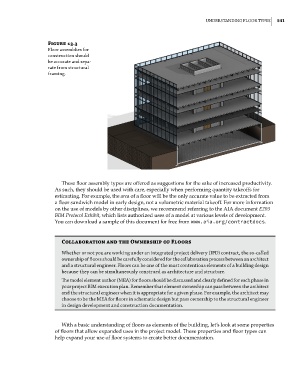Page 575 - Divyank Tyagi
P. 575
|
Understanding Floor tYpes 541
Figure 13.3
Floor assemblies for
construction should
be accurate and sepa-
rate from structural
framing.
These floor assembly types are offered as suggestions for the sake of increased productivity.
As such, they should be used with care, especially when performing quantity takeoffs for
estimating. For example, the area of a floor will be the only accurate value to be extracted from
a floor sandwich model in early design, not a volumetric material takeoff. For more information
on the use of models by other disciplines, we recommend referring to the AIA document E203
BIM Protocol Exhibit, which lists authorized uses of a model at various levels of development.
You can download a sample of this document for free from www.aia.org/contractdocs.
Collaboration and the Ownership of Floors
Whether or not you are working under an integrated project delivery (ipd) contract, the so-called
ownership of floors should be carefully considered for the collaboration process between an architect
and a structural engineer. Floors can be one of the most contentious elements of a building design
because they can be simultaneously construed as architecture and structure.
The model element author (Mea) for floors should be discussed and clearly defined for each phase in
your project BiM execution plan. remember that element ownership can pass between the architect
and the structural engineer when it is appropriate for a given phase. For example, the architect may
choose to be the Mea for floors in schematic design but pass ownership to the structural engineer
in design development and construction documentation.
With a basic understanding of floors as elements of the building, let’s look at some properties
of floors that allow expanded uses in the project model. These properties and floor types can
help expand your use of floor systems to create better documentation.
c13.indd 541 05-05-2014 16:57:10

